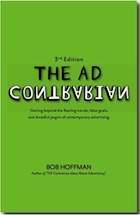
RATING: 8/10…READ: September 29, 2012
Traditional marketing is dead! Social Media is King! – This is the advice ad man Bob Hoffman rejects in this book, ignoring the cult of social media marketers claiming its the future of advertising. Instead, it’s a book of well tested advertising principles that have existed throughout history, not a fad of the moment–ignoring such jargon like “branding” being an action instead of a result of great products and services.
Notes:
Consumers have shown no interest at all in interacting with our advertising.
like the Yellow Pages, the web has proven so far that it’s far more effective at fulfilling demand than creating it.
It is a way to hide the ultimate advertising truth: creating advertising is largely precision guessing.
the ultimate Catch-22. When the product sells well, it’s because the ads are brilliant. When the product doesn’t sell well, it’s not supposed to—it’s a branding campaign.
Great brands have never been created by “branding.” Great brands have been created by excellent product advertising and patience.
Brands need character, not tattoos.
The idea that a strong brand can be created through branding is wrong. Some things can only be achieved indirectly. You can’t be happy by trying to be happy. If you want to be happy you have to go fishing, or eat a pizza, or clean out your closet.
You want to have a good marriage? Stop trying so hard. Go to Hawaii. Play Scrabble. Or even better, leave each other alone.
You want to have a strong brand? Quit branding. A strong brand is a by-product. It comes from doing a lot of other things right. For example:
1. Make sure you’re selling excellent products.
2. Make sure you’re taking good care of your customers.
3. Make sure your ads demonstrate how you are different from and better than your competitors.
That’s what builds brands, and that’s all you need to know. The rest is chitchat.
When’s the last time you saw a car ad with an old person in it? And yet, of the 13 cars the average American will buy in a lifetime, 8 of them will be bought after the age of 50.
the hard part of solving marketing problems is not getting more information— it’s figuring out the meaning of the information we already have.
They go to Target today and Wal-Mart tomorrow. They wear Nikes today and Adidas tomorrow. They sign up for Verizon today and AT&T tomorrow. Most of their buying decisions are for specific, immediate reasons. Not for mysterious sociological, cultural, or emotional reasons.
if your principles are centered around “engagement,” “conversations,” and “relationships” they’re not principles. They’re clichés.
No one will ever say it better than David Ogilvy, “The essence of strategy is sacrifice.”
“[Online] surveys tend to poll the same people over and over.” In fact, a study done by ComScore Networks indicated that one-quarter of one percent of the population provides almost 33% of all online responses. This means that instead of getting one vote, each of these respondents is getting the equivalent of 128 votes.
As long as I’ve been around advertising (which is hundreds of years) the failure rate of new products has been in the 90+% range.
It’s getting harder and harder for me to believe that they have all the information, but we are in charge. To believe this you also have to believe that knowledge is not power.
There are some corners of the ad industry in which people really do know what works. The direct response people know that offers work. The political people know that attack ads work. But these strategies are often outside the lines of mainstream product advertisers.
Performance-Based Advertising has three principles:
Advertising is most productive when it is focused on changing behavior, not attitudes.
Advertising messages should be created for, and directed at, the heavy-using, high-yield customers in your category.
We don’t get people to try our product by convincing them to love our brand; we get them to love our brand by convincing them to try our product.
It does not require any special knowledge of psychology or neuroscience to observe that human beings are generally reluctant to change their minds.
We know a heavy traveler who dislikes United intensely. He’s had years of unpleasant experiences with United. He goes out of his way to avoid them. This year, United will spend tens of millions of dollars advertising to him and people like him. They can play Rhapsody in Blue till they’re blue in the face, and it won’t change his attitudes or get him to like the airline any better. But they can change his behavior very easily. All they need to do is promise him a 5-minute security line or a $299 fare to Hawaii, and he’ll have his shoes off and his boarding pass out so fast you won’t believe it.
in the fast-food category, as in many others, about 30% of customers account for 70–80% of the volume.
success in most categories is directly related to the number of heavy-using, high-yield customers you can attract. (I have used “heavy user” and “high-yield customer” interchangeably. In some categories they may not be the same.)
As Southwest demonstrates, the best way to build a brand is with persuasive product advertising.
You want to build a strong brand? Forget the ethnography, sociology, sidewalk psychology, and brand babble. Make sure your advertising gives people a damn good, convincing reason to change their behavior.
